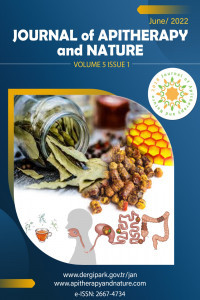Propolis: Pharmacological Properties and Medical Applications of Propolis in Modern Medicine
Propolis: Pharmacological Properties and Medical Applications of Propolis in Modern Medicine
___
- .
- Yayın Aralığı: Yılda 2 Sayı
- Başlangıç: 2018
- Yayıncı: Oktay YILDIZ
Chemical Profiling of Tropical Propolis: Challenges and New Data
Milana POPOVA, Boryana TRUSHEVA, Kristina GEORGIEVA, Vassya BANKOVA
Thirteen Flavonoids from Green Propolis from Minas Gerais, Brazil, Analyzed for Six Years
M. D. FREITAS, G. A. LOPES, N. A OLIVEIRA, B. M. ALMEIDA, S. R. L. ABREU, R. C. BASQUES, N. S. BINDA, S. M. FIGUEIREDO
The Impact of Honeybee Origin on the Quality of Propolis
Gomes da Silva CAHANGO, Soraia I. FALCÃO, Miguel VILAS-BOAS
The Biological Activities of Indonesian Propolis and It’ s Molecular Marker
Muhamad SAHLAN, Diah Kartika PRATAMI, Safira Candra ASIH, Andrea DEVINA, Alfiani Guntari MAHADEWI, Masafumi YOHDA, Siti FARIDA, Robiatul ADAWIYAH, Herbert SITUMORANG, Heri HERMANSYAH, Anondho WIJANARKO
Mihaela NICULAE, Laura STAN, Adriana URCAN, Timea DOMOKOS, Daniel S. DEZMIREAN, Otilia BOBIS
Antituberculosis Activity of Propolis
Jarosław WIDELSKI, Joanna GOLUS, Piotr OKIŃCZYC, Rafał SAWICKI, Grażyna GINALSKA, Tomasz MROCZEK, Zuriyadda SAKIPOVA, İoanna CHINOU, Krystyna SKALICKA-WOŹNIAK
Ana Sofia P. FREITAS, Ana João P. GOMES, Ana CUNHA, Rui P. S. OLIVEIRA, Cristina ALMEIDA-AGUIAR
İsamara Julia CAMURI, Adriano Batista COSTA, Wallance Moreira PAZIN, Amando Siuiti ITO
The Influence of Propolis on Liver Pathology in Broilers
Maja MISKULIN, Ivana KLARIC, Matija DOMACINOVIC, Berislav PRAKATUR, Albina DUMIC, Daniela Cacic KENJERIC, İvan MISKULIN
Phenolic Compounds of Spain Propolis
Félix ADANERO-JORGE, M Camino GARCÍA-FERNÁNDEZ, Rosa M VALENCIA-BARRERA, J. Javier SANZ-GÓMEZ
